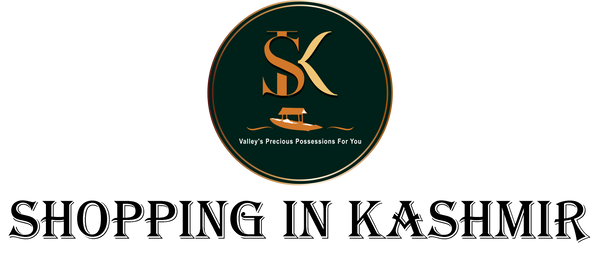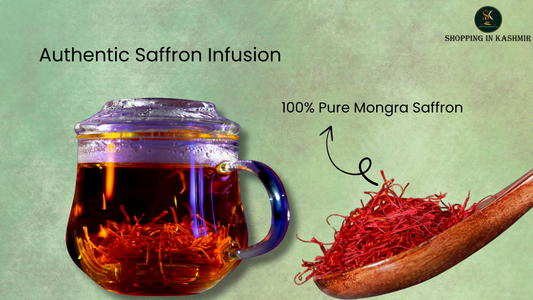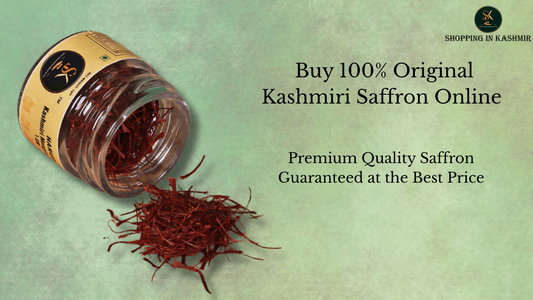What is the best price for original Kashmiri Saffron (Kesar) ?
Share
Table of Contents
What is the best price for original Kashmiri Saffron (Kesar) ?
What is the best grade of saffron in Kashmir?
- Mongra Saffron (Highest Quality, Grade 1 Saffron):
- Lachha Saffron:
- Guchhi Saffron:
Kashmiri Saffron Prices by Weight: Per Gram, Ounce, and Kilogram
- How much is 1 gram of saffron?
- What is the price of 1 ounce (28 grams) of saffron?
- What is the cost of 1 kg saffron (kesar)?
Why Kashmiri Saffron Is So Expensive
- 1. Labour-intensive cultivation and harvesting of Saffron
- 2. Unique hand processing of Mongra saffron
- 3. Limited yield from each saffron flower
- 4. Geography and climate you cannot copy
- 5. Geographical Indication (GI) tag
- 6. Global demand, limited supply of Kashmiri Saffron
- Where to Buy 100% Original Kashmiri Saffron?
- Products Made with Authentic Kashmiri Mongra
Conclusion
We guess you have finally decided to buy pure Kashmiri saffron, and now you are looking for the best price. With saffron prices ranging from suspiciously cheap to shockingly high, it is easy to feel lost. The fair price of pure Kashmiri Kesar is not guesswork. It comes down to grade, how it is harvested and processed, and proof of origin.
Just as gold prices make headlines, so do Kashmiri saffron prices: ₹3.5–₹3.6 lakh per kg in the wholesale market, and up to ₹4.95 lakh per kg at retail. Big numbers, we know. Such figures make anyone pause and ask: why is saffron so expensive, and is it worth the price?
Let us get to the truth of what should saffron cost in 2025?
What is the best grade of saffron in Kashmir?
Kashmiri Mongra Saffron is often considered the best in the world. Its unparalleled quality, deep-rooted cultural significance, and superior taste keep it at the top of the market as Grade 1.
Before buying Kashmiri saffron, first decide which grade of Kashmiri saffron you want, since the price of saffron largely depends on it. It is categorized into three main grades based on how it is processed and which part of the stigma is used:

- Mongra Saffron (Highest Quality, Grade 1 Saffron)
The purest and most expensive grade, consisting only of deep red crimson stigmas. It offers the strongest flavor, color, and aroma. It is mostly used in fine-dining recipes and traditional medicine.
- Lachha Saffron:
This grade of saffron includes both red stigmas and yellow styles, balancing affordability with quality. It is commonly used in everyday cooking and infusions.
- Guchhi Saffron:
Similar to Lachha, but the stigmas are bundled together with a cloth thread.
Kashmiri Saffron Prices by Weight: Per Gram, Ounce, and Kilogram
Each grade of saffron is sold by weight. Prices rise with grade and fall with volume. That is why a 28 g pack usually costs less per gram than single-gram boxes of saffron.
Here’s what 1 g, 28 g, and 1 kg of Kashmiri saffron typically cost in Kashmir, India. The prices below refer to Kashmiri Mongra (Grade 1) saffron; lower grades generally cost less.
How much is 1 gram of saffron?
The price of 1 g Kashmiri Mongra saffron sold by reputable Kashmiri (Indian) retailers is around ₹500–₹600 per gram. This quantity is good for first-time buyers, recipe testing, and gifting samplers.
What is the price of 1 ounce (28 grams) of saffron?
In India, ₹8,500–₹13,000 for 28 g is common for top-grade Mongra. Bulk buys may push the unit price slightly lower. Buying 28 g often lowers the per-gram cost versus 1 g boxes of saffron. This is a good option for home cooks who use saffron regularly, festive cooking, and premium gifts.
What is the cost of 1 kg saffron (kesar)?
Buying saffron in bulk, such as in kilogram quantities, is often the most economical way to purchase it. The cost of 1 kilogram of authentic Kashmiri Mongra saffron ranges between ₹4,00,000 and ₹4,50,000 per kilogram, depending on the brand and supplier discounts. A 1 kg quantity is usually purchased by restaurants, confectioners, wellness brands, and exporters.
Why Kashmiri Saffron Is So Expensive
Kashmiri saffron is rare, painstaking to produce, and protected for its origin and quality. Its high price comes from a mix of factors that few other spices share.
Labour-intensive cultivation and harvesting of Saffron

The saffron crocus (Crocus sativus) does not produce viable seeds, so farmers use corms, which are dug up, divided, and replanted each year. This makes cultivation slow and hands-on. Harvesting is just as demanding. Flowers bloom once a year for a short autumn window. They are picked at dawn until around 9 or 10 a.m., before wilting begins. The blooms are gathered in wicker baskets and dried in the sun to preserve aroma, flavour, and colour.
- Unique hand processing of Mongra saffron
After harvesting, only the dried stigmas are kept. In Kashmir, artisans use a traditional method called “Loût Czhttun” or “tail cutting” to separate the prized red portion of the stigma from the yellow style. It looks simple but needs skill and precision. This is why Kashmiri Mongra saffron which keeps only the deep red tips commands a higher price. The extra care adds exclusivity and value.
- Limited yield from each saffron flower
Each flower has only three delicate red stigmas. To produce 1 kilogram of dried saffron, farmers must harvest about 1,50,000 to 2,00,000 flowers.
Yes, hundreds of thousands.
That usually means cultivating an area roughly the size of a football field. Every step is manual, and the threads are fragile, so the labour cost per gram is naturally high.
- Geography and climate you cannot copy
Pure Kashmiri saffron grows mainly in Pampore, Kashmir, where high altitude, well-drained soils, clean meltwater, and crisp winters create ideal conditions. This is not easily replicated elsewhere. The crop is highly localised, which keeps supply limited and quality distinct, and it is a big reason Kashmiri saffron is considered among the best in the world.
- Geographical Indication (GI) tag
Kashmiri saffron carries a GI tag, a certification that protects its origin and sets quality standards. It helps buyers avoid fakes and assures them they are getting genuine, unadulterated Pampore saffron. Protection and verification support premium pricing.
- Global demand, limited supply of Kashmiri Saffron
Saffron is used in food, cosmetics, and pharmaceuticals, so demand stays strong. In India, it also peaks during festivals and weddings. When demand rises faster than supply, prices climb. With a short harvest season and small yields, even minor supply shifts can move the market.
Every thread you see has been planted, picked, trimmed, and dried by hand, in a place with the right altitude and climate. That is why authentic Kashmiri kesar costs more and why it holds its value.
Where to Buy 100% Original Kashmiri Saffron?

Buying genuine Kashmiri saffron matters because it is an expensive spice. Fakes and adulterated mixes are common, and today’s online and local markets are crowded with options, so careful selection is essential.
When you shop for pure Kashmiri saffron, make authenticity your first filter, identify the original Kashmiri Mongra Saffron. Many sellers mix grades or offer low-quality product, which makes finding the real thing challenging. That is where Harud, a vertical of Shopping in Kashmir, helps.
Choose known brands or sellers who source directly from Kashmir. Just like we work with Pampore farmers to supply 100% pure saffron, handled carefully from farm to package and priced transparently.
Always compare prices and read reviews; if a deal looks unrealistically low, it probably is. Further, prices vary by supplier, so compare per gram or per ounce. Genuine, high-grade Kashmiri saffron should match the ranges shared above. Some sellers may charge a little less for bulk packs or direct farm channels, but extremely low prices are a red flag for adulteration.
At Harud, we take it as our responsibility to deliver pure, unadulterated saffron sourced directly from the fields of Pampore, Kashmir. With us, you get premium quality at fair, market-aligned prices.
Products Made with Authentic Kashmiri Mongra
Alongside our pure mongra saffron, we have infused everyday staples with the same authenticity: Harud Kashmiri Sugar-Free Kehwa Mix, Harud Kashmiri Shahi Kehwa Instant Mix, and Harud Kashmiri Saffron Honey. Each is made with original Mongra (Grade 1) Kashmiri saffron.
The Sugar-Free Kehwa Mix pours a clean, balanced cup without added sugar, with Kashmiri Mongra Saffron lending a warm floral note and natural golden colour.
The Shahi Kehwa Instant Mix delivers a more indulgent, festive profile in minutes, turning a quick brew into a fragrant Kashmiri experience.
Our Saffron Honey folds real Mongra strands into pure honey for a gently floral sweetness that elevates tea, warm milk, toast, or desserts. It increases the nutrient profile and amplifies the health benefits of pure Kashmiri honey. Buy 100% pure and best Kashmiri honey online.
We use Mongra saffron in these products for a reason. It enriches the flavour. It keeps the authentic spirit of Kashmir alive, from Pampore to your cup and into every heart.
Conclusion
Kashmiri Mongra saffron lives up to its “red gold” name. Its bright colour, potent aroma, and health benefits justify the premium. Paying less than this usually means compromising on purity or grade. As long as you buy from a certified seller who guarantees pure Grade 1 saffron, the high cost simply reflects what it takes to grow and process this spice.
If you have decided to buy 1 g or 1 kg of Kashmiri saffron online, choose Shopping in Kashmir to taste authentic Kashmiri kesar. It may be a luxury purchase, but for many cooks and connoisseurs, pure Kashmiri saffron is worth every rupee.









